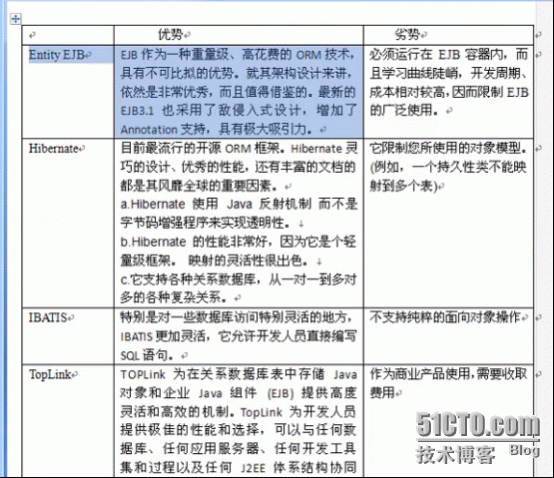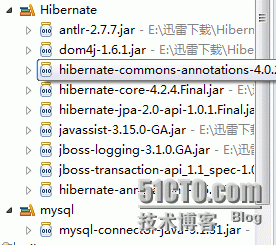Hibernate第一個實例
1、Hibernate優點:
(1)簡化開發,提高開發效率
底部封裝數據庫操作,使用起來更加簡潔方便
(2)更加面向對象設計
只用關心按照面向對象的方法實現業務邏輯,不用關心數據庫等創建於操作。
數據庫:是關係數據庫,是面向關係的。而java是面型對象的,所以需要ORM(對象關係映射)。而Hibernate直接封裝好了之間的映射。
(3)更好的性能
Hibernate中使用hql語句進行數據操作,hql相對於sql語句效率稍微低一點,因爲hql要生成sql語句進行數據庫操作,而且sql還可以進行優化。但是生成的sql效率很高,比一般程序員寫的語句可能更高,而且還設置的有緩存機制。兩者決定着性能的高低。
(4)更好的移植性
底層數據庫屏蔽,根據數據庫的不同,進行轉化。直接寫hql語句就行,不用關係具體數據庫操作。
2、ORM框架比較:
3、JPA 全稱:Java Persistence API(運行時把實體對象持久到數據庫中)
Hibernate、Spring、OpenJPA、Toplink等都是JPA的實現。(但是HIbernate早於JPA的實現)
JPA是javaee5.0的亮點。
SessionFactory一個應用只有一個,二級緩存,創建session對象。
一個session對象只有在一個線程中使用
4、初步學習(Hibernate第一個實例)
(1)加入包
Hibernate包和數據庫連接:
(2)建立Hibernate配置文件(hibernate.cfg.xml)
<?xml version="1.0" encoding="UTF-8"?>
<!DOCTYPE hibernate-configuration PUBLIC
"-//Hibernate/Hibernate Configuration DTD 3.0//EN"
"http://hibernate.sourceforge.net/hibernate-configuration-3.0.dtd">
<hibernate-configuration>
<!-- 從官方文檔hibernate.property中獲取(裏面有連接各種數據庫的實例) -->
<session-factory>
<property name="show_sql">true</property>
<property name="hibernate.dialect">org.hibernate.dialect.MySQL5Dialect</property>
<property name="hibernate.connection.driver_class">com.mysql.jdbc.Driver</property>
<property name="connection.url">jdbc:mysql://localhost:3306/hibernate</property>
<property name="connection.username">root</property>
<property name="connection.password">abc123</property>
<!-- JDBC connection pool (use the built-in) -->
<property name="connection.pool_size">1</property>
<!-- Enable Hibernate's automatic session context management -->
<property name="current_session_context_class">thread</property>
<!-- Disable the second-level cache -->
<property name="cache.provider_class">org.hibernate.cache.NoCacheProvider</property>
<!-- Drop and re-create the database schema on startup -->
<property name="hbm2ddl.auto">update</property>
<mapping resource="hibernate/test/xml/Student.hbm.xml"></mapping>
</session-factory>
</hibernate-configuration>
(3)建立實體類
package hibernate.test.domain;
public class Student {
private int id;
private String sNo;
private String name;
private String pass;
private String schoolName;
public int getId() {
return id;
}
public void setId(int id) {
this.id = id;
}
public String getsNo() {
return sNo;
}
public void setsNo(String sNo) {
this.sNo = sNo;
}
public String getName() {
return name;
}
public void setName(String name) {
this.name = name;
}
public String getPass() {
return pass;
}
public void setPass(String pass) {
this.pass = pass;
}
public String getSchoolName() {
return schoolName;
}
public void setSchoolName(String schoolName) {
this.schoolName = schoolName;
}
public Student(String sNo, String name, String pass,
String schoolName) {
super();
this.sNo = sNo;
this.name = name;
this.pass = pass;
this.schoolName = schoolName;
}
public Student() {
super();
// TODO Auto-generated constructor stub
}
}
(4)建立對應實體類的映射文件(student.hbm.xml)
<?xml version="1.0" encoding="UTF-8"?>
<!DOCTYPE hibernate-mapping PUBLIC
"-//Hibernate/Hibernate Mapping DTD 3.0//EN"
"http://hibernate.sourceforge.net/hibernate-mapping-3.0.dtd">
<hibernate-mapping package="hibernate.test.domain">
<class name="Student" table="student" lazy="true">
<id name="id">
<generator class="native"/>
</id>
<property name="sNo" column="sno" not-null="true" type="java.lang.String"></property>
<property name="name" type="java.lang.String"></property>
<property name="pass" type="java.lang.String"></property>
<property name="schoolName" type="java.lang.String"></property>
</class>
</hibernate-mapping>
(5)測試類
public class Test1 {
public static void main(String[] args) throws SecurityException, RollbackException, HeuristicMixedException, HeuristicRollbackException, SystemException {
// TODO Auto-generated method stub
Configuration configuration=new Configuration();
configuration.configure();
SessionFactory sessionFactory=configuration.buildSessionFactory();
Session session=sessionFactory.openSession();
//必須加事務,要麼數據庫就沒有插入數據
Transaction transaction=session.beginTransaction();
Student student=new Student("201200834201","name","000000","zhongyuangongxueyaun1");
session.save(student);
transaction.commit();
session.close();
}
}
Hibernate事務默認是不提交的,增刪改都需要提交事務,查不需要提交事務
5、單例模式(SessionFactory一個web應用中只有一個)
封裝session:
package hibernate.test.test;
import org.hibernate.Session;
import org.hibernate.SessionFactory;
import org.hibernate.cfg.Configuration;
public class HibernateUtil {
private static SessionFactory sessionFactory;
private HibernateUtil(){
}
static{
Configuration configuration=new Configuration();
configuration.configure("hibernate.cfg.xml");
sessionFactory=configuration.buildSessionFactory();
}
public static SessionFactory getSessionFactory(){
return sessionFactory;
}
public static Session getSession(){
return sessionFactory.openSession();
}
}
Test2中調用session,向數據庫插入數據,測試如下:
package hibernate.test.test;
import hibernate.test.domain.Student;
import org.hibernate.Session;
import org.hibernate.Transaction;
public class Test2 {
public static void main(String[] args) {
// TODO Auto-generated method stub
Session session=null;
Transaction tx=null;
try {
session=HibernateUtil.getSession();
tx=session.beginTransaction();
Student student=new Student("201200834202","nameytt","000000","zhongyuangongxueyaun1");
session.save(student);
tx.commit();
} catch (Exception e) {
// TODO: handle exception
if(tx!=null)
{
tx.rollback();
}
throw e;
}
finally{
if(session!=null)
{session.close();}
}
}
}
插入成功!
6、Hibernate生命週期
見:http://www.cnblogs.com/wangchenyang/archive/2011/08/23/2150373.html
public static void main(String[] args) {
// TODO Auto-generated method stub
Session session=null;
Transaction tx=null;
try{
session=HibernateUtil.getSession();
tx=session.beginTransaction();
//通過反射機制去獲取對象
//如果id=2的記錄不存在,返回null。get方法是在緩存(session中 一級緩存)中進行查找,若無,再在sessionFactory(二級緩存)中進行查找,若無,再連接數據庫重新查找
Student student=(Student) session.get(Student.class, 2);
System.out.println(student.getName());
//如果id=2的記錄不存在,則會拋出異常,一般用於這個記錄一定存在的情況。該方法有懶加載。
//Student student2=(Student) session.load(Student.class, 2);
student.setName("ytt_01");
session.save(student);
System.out.println(student.getName());
tx.commit();
} catch (Exception e) {
// TODO: handle exception
if(tx!=null)
{
tx.rollback();
}
throw e;
}
finally{
if(session!=null)
{
session.close();
}
}
}


